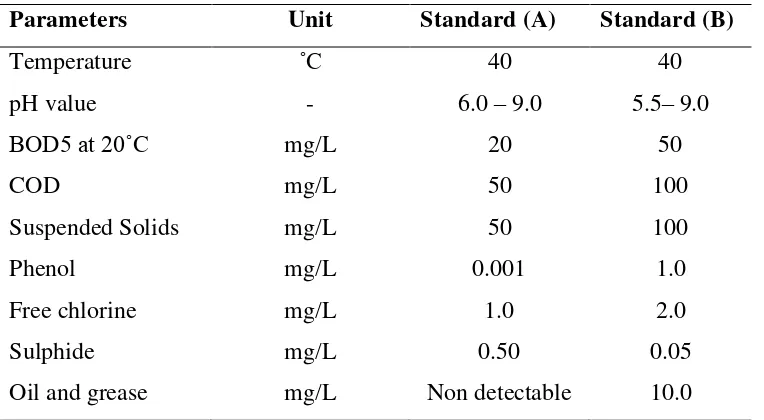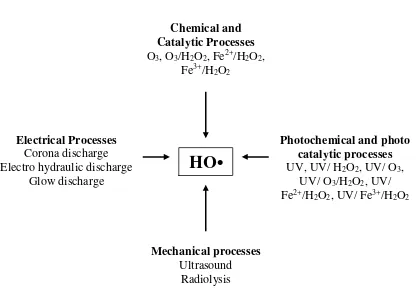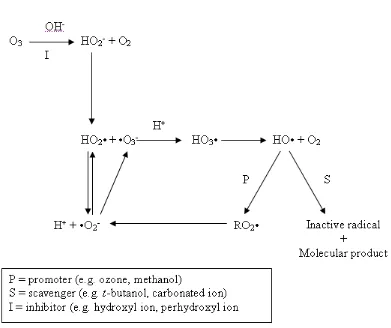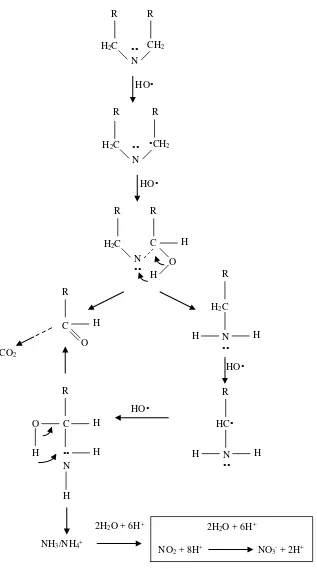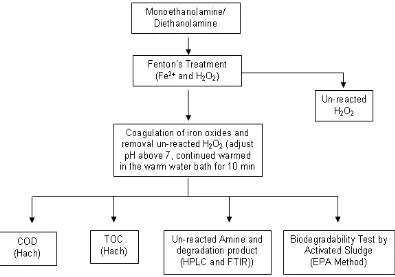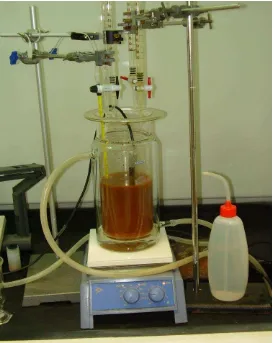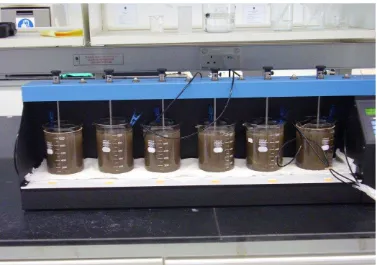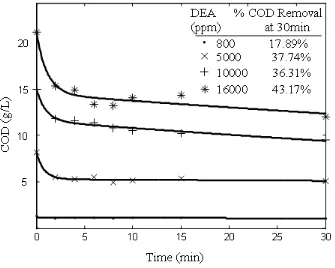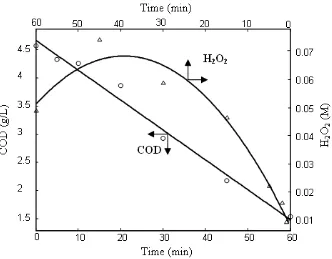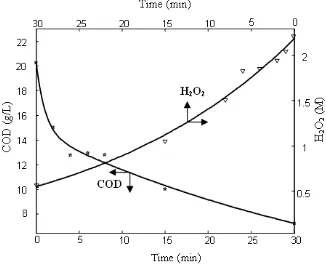i
iii
UNIVERSITI TEKNOLOGI PETRONAS
“Degradation Kinetics of MEA and DEA by Fenton’s Reagent with Biological Post-Treatment”
By
Sabtanti Harimurti
A THESIS
SUBMITTED TO THE POSTGRADUATE STUDIES PROGRAMME AS A REQUIREMENT FOR THE DEGREE OF MASTER OF SCIENCE
IN CHEMICAL ENGINEERING
BANDAR SERI ISKANDAR, PERAK
iv
I hereby declare that the thesis is based on my original work except for quotations and citations which have been duly acknowledged. I also declare that it has not been previously or concurrently submitted for any other degree at Universiti Teknologi PETRONAS or other institutions.
Signature :
Name : Sabtanti Harimurti
v
ACKNOWLEDGEMENT
First of all, this work could not be accomplished without Allah permission. Allah creates all knowledge in this universe we live in. If the ocean were ink (wherewith to write out) the words of Allah, sooner would the ocean be exhausted than would the words of my Lord, even if we added another ocean. Our knowledge is just as a small drop of water from the ocean. Therefore, all the contributions that I can provide in this work are for the shake of Allah only.
This work could not completed on time in two and half years without all valuable helps of my supervisor, Prof Dr. Binay K Dutta. I would not forget about his patience in guiding me to write the dissertation. I would like to thank Pn. Putri N Faizura Megat Khamaruddin for her helpful comments in course of my research work. I would like to thank Associate Prof Dr. Suzana Bt. Yusof for her support and wisdom as Head of Chemical Engineering Department, UTP.
Special thanks to my family (Ayok, Lutfi, and Qornain), for their love, patience and faith all the days throughout this two and half years of my master study in UTP.
vi
Raihan Mahirah, Idhzam Fauzi, Faizal Haris, Welly Herimurti, Kiki Adikurnia, Saepurahman, Merry Hastuti, Sominidevi, Nurul Huda, Kamaleshwaran, and Vicknesh, for their kind consideration and cooperation during research works of this study.
Special thanks go to Surya, Amelia, Nga, Ameer, Omer, Fauzan, Zulfan and Jody. Because all of you my GA works were colorful.
For all of you in the sport hall, especially Mbak Etik, Ari, Fitri, Inung and Afny thank you very much for partner sharing to play badminton and I would not like to forget anything in the swimming pool. Without all of that I am sure I could not sustain in the hard lab work.
vii
Alkanolamines in aqueous solutions are commonly used for scrubbing of carbon dioxide from natural gas, synthesis gas and other gas mixtures. Large quantities of amines appear in the wastewater during cleaning and maintenance as
well as shutdown of the absorption and desorption columns. The amines are not readily biodegradable and such wastewater cannot be treated in the conventional
treatment facility. Advanced Oxidation Processes (AOP), such as oxidation by Fenton’s reagent, UV-H2O2 and UV-Ozone offer a class of techniques of treatment or
partial degradation of recalcitrant organics which are not readily amenable to conventional biological oxidation. Degradation of alkanolamines by Fenton’s reagent
has been investigated in this work. Mono- and di-ethanolamines have been selected as two model alkanolamines. Fenton’s oxidation experiments were conducted in a
jacketed glass reactor and the effects of process parameters such as dosing of the reagents (H2O2 and FeSO4;7H2O), pH, initial concentration of the amine as well as the
mode of addition of the reagents have been studied in details. Since the degradation process involves a number of intermediates, not all of which could be identified, the
chemical oxidation demand (COD) of the amine solution is selected as a measure of the extent of degradation. Determination of the COD was done by Hach 5000 spectrophotometer following the standard procedure. FTIR Spectrometer and HPLC
were used for identification and analysis of the degradation fragments. Amine concentrations upto 20,000 ppm was used since it is characteristic of the effluents
viii
having a higher initial amine concentration, the degradation process was very fast.
Most of the total COD removal was attained within a few minutes from the start of the reaction. This was followed by a very slow rate of COD removal. The reaction rate as
well as the extent of reaction was most favored at a pH of 3. Also the rate of degradation passes through a maximum with increase of H2O2 dosing and the
Fe2+/H
2O2 ratio. Continuous addition of the Fenton’s reagent is much more effective
with better utilization of the H2O2 than one-time addition. Besides COD, time
evolution of the concentrations of the amine and hydrogen peroxide were measured to
monitor the course of the reaction. A rapid fall of H2O2 concentration accompanied established. This indicates that the alcohol group of an alkanolamine might be more vulnerable to electrophilic attack by the HO• radicals than the α-carbon atom with
respect to the alcohol group. A plausible reaction pathway is suggested and a rate equation for MEA degradation was developed.
A high dose of Fenton’s reagent was not of help to increase the COD
reduction. With addition of the stoichiometric quantities of the regent, the degradation amounted to only about 60% COD removal even though about 98% of H2O2 as
ix
rate was slower than the pure substrate. Since 40-50% of the COD remains in the
Fenton-treated solution, we explored the biodegradability of the organic fragments and oxidation products. The biodegradability test was carried out in an aerobic batch
reactor prescribed by the materials and methods specifications in the Zahn-Wellens/EMPA Test according to the US Environmental Protection Agency (EPA) method OPPTS 835.3200. Partially degraded alkanolamines after about 40% COD removal by Fenton’s oxidation was used to study the biodegradability. The biological
oxidation of untreated alkanolamine was done in parallel. The COD in solution as
well as the biomass concentration was monitored to follow the course of the reaction. The pH of the medium ranged between 6.5 – 8. No attempt to maintain a constant pH by buffering was made in order to ascertain the usefulness of the method under industrial operating conditions. ‘Activated sludge’ from the central wastewater
treatment unit of this university was used for seeding the batch bioreactor. The results show that the acclimatization time for biological oxidation of a partially degraded amine sample was about the half of that of the ‘pure’ amine. The time of maximum
COD removal was also shorter for the former sample. The kinetics of biomass growth
could be fitted by the Monod equation. The kinetic constants were evaluated.
Emission of ammonia from the reactor was detected and an ammonia probe
was used to monitor the formation of ammonia during the biodegradation process. It appears that ammonia formation per unit COD of the partially degraded sample was more than that of a ‘pure’ amine. This observation is compatible with the formation of
x
strategy of treatment of amine-laden wastewater in natural gas-treating plants.
xi
Alkanolamines adalah satu larutan yang selalu digunakan untuk tujuan menyingkirkan gas carbon dioxide daripada kandungan gas asli, gas sintesis dan juga
gas-gas yang lain. Semasa penyelengaraan absorption dan desorption columns sejumlah besar kandungan amines ditemui dalam air kumbahan yang dikeluarkan melaluinya. Larutan amines sukar untuk dihuraikan secara biological dan ini
menyebabkannya sukar dirawati melalui rawatan convensional. Advanced Oxidation Processes (AOP), seperti pengoxidaan dengan menggunakan Fenton reagent,
UV-H2O2 dan UV-Ozone dapat membantu dalam penghuraian kandungan bahan buangan
secara separa supaya ia dapat kemudiannya dirawati melalui rawatan biological.
Kajian terhadap penghuraian Alkanolamines dilakukan dengan lebih terperinci dalam tugasan ini. Dalam kajian ini jenis alkanolamines yang digunakan adalah mono dan di-ethanolamines. Experimen ini dijalankan didalam sebuah kelalang dimana
parameter seperti nilai pH, consentrasi amine, kandungan H2O2 dan FeSO4, 7H2O
serta kandungan tambahan reagen lain telah dibuat kajian secara terperinci.
Disebabkan tidak kesemua bahan huraian dapat dikesan atau dikaji, nilai COD digunakan sebagai kraiteria dalam menyukat tahap penghuraian. Tahap COD diukur dengan mengunakan sistem HACH 5000 spectrophotometer melalui langkah
pengunaannya. FTIR Spectrometer dan HPLC dapat digunakan untuk mengkaji kandungan hasil penghuraian. Bagi menepati tahap konsentrasi kandungan yang
xii
konsentrasi amine yang tinggi membantu mempercepatkan riaksi pemerosesan.
Didapati bahawa cuma beberapa minit sahaja diperlukan bagi meneutralkan kesemua kandungan COD dalam larutan yang digunakan. Selepas penurunan yang mendadak,
penurunan COD akan kembali pelahan. Didapati bahawa pH yang sesuai bagi experiment ini adalah dalam lingkungan 3. Melalui experiment yang dijalankan didapati bahawa penghuraian yang maksima dapat diperolehi melalui penambahan
kandungan H2O2 dan Fe2+/H2O2 .Penambahan kandungan fenton yang berterusan
didapati lebih efektif terutama sekali bagi H2O2 berbanding penambahan sekaligus.
Selain kandungan COD, penglibatan masa juga dititikberatkan dalam experiment ini untik mengetahui bagaimana masa dapat memanupulasikan tindak balas kimia. Penurunan konsentrasi H2O2 yang mendadak menandakan perununan COD yang
pantas. Didapati kadar kecerunan graph bagi penambahan reagent yang berterusan adalah rendah berbanding penambahan sekaligus. Trand yang sama diperolehi bagi MEA dan DEA.
Walaupun sukar bagi kita untuk mengenal pasti kesemua jenis bahan kimia yang terhasil daripada penghuraian amines, glycine adalah salah satu bahan
persementaraan yang dapat dikesan dalam experiment ini. Ini menunjukkan bahawa serangan electrophilic daripada HO• radical terhadap alkanolamine adalah lebih tinggi berbanding atom carbon-α. Dengan ini satu formula reaksi bagi penghuraian telah
dibentuk.
Pengunaan kandungan Fenton yang berlebihan tidak membantu dalam
xiii
98%. Melalui proses pengoxidasian, salah satu hasil penghuraian daripada amine
yalah glycine. Tahap penghuraiannya adalah lebih pelahan berbanding penghuraian kandungan yang tulin. Disebabkan kadar kandungan COD yang masih tertinggal
dalam larutan Fenton yang telah dirawati, kami telah membuat kajian yang lebih terperinci tentang kadar penghuraian bahan organik serta produk oxidasinya. Experiment untuk mengetahui kadar penghuraian bahan organiknya dilakukan dalam
sebuah reactor aerobic. Penjelasan bagi langkah pengunaannya dihuraikan dalam kajian Zahn-Wellens/EMPA yang menepati kritiria EPA, (US Environmental
Protection Agency (EPA) method OPPTS 835.3200). Alkanolamines yang separa-terhurai ( selepas 40% kandungan COD telah dikeluarkan melalui pengoxidaan melalui process Fenton) digunakan dalam mengkaji kadar penghuraian bahan organik.
Pengoxidaan biological dilakukan secara separa keatas alkanolamine. Kandungan COD serta tahap kandungan Biomass diteliti untuk mengetahui langkah pemerosesannya. Tahap pH dalam larutan dikawal supaya berada dalam lingkungan
6.5 hingga 8. Buffer tidak ditambah bagi mengawal nilai pH untuk mengoptimalkan operasi didalam industry. ‘Activated sludge’ yang diambil daripada unit kumbahan
universiti digunakan dalam bio reactor. Keputusan experiment menunjukkan bahawa masa bagi rawatan amine yang separa terhurai adalah separuh daripada masa yang
diperlukan untuk merawati kandungan amine yang tulin. Masa yang diperlukan bagi penurunan COD secara maksimum adalah lebih singkat berbanding sempel yang sebelumnya. Perubahan kinatik biomass ini dapat dijelaskan melalui “Monod
xiv
digunakan bagi mengesan pembentukan ammonia semasa penghuraian secara
biological dalam process. Didapati bahawa pembentukan ammonia per unit COD dalam sempel yang telah melalui penghuraian separa adalah lebih daripada amine
yang tulin. Experiment menunjukkan bahawa banyak kandungan telah dioksidakan kepada amino-acid melalui pengoxidaan Fenton. Keputusan daripada kajian ini dapat member manafaat dalam membentuk langkah untuk marawati air kumbahan
xv
CHAPTER 1: INTRODUCTION ... 1
1.1.Background of Research ... 1
1.1.1. Natural Gas Processing ... 2
1.1.2. CO2 and H2S Removal from Natural Gas ... 2
1.1.3. The Hybrid Process ─Advanced Oxidation followed by BiologicalTreatment─ ... 5
1.2.Problem Statement ... 6
1.3.Objectives ... 7
1.4.Scope of Work ... 7
CHAPTER 2: LITERATURE REVIEW ... 9
2.1. Industrial wastewater ... 9
2.1.1. Wastewater Characteristics ... 9
2.1.2. Wastewater Regulations... 10
2.1.3. Wastewater Treatment Methods ... 11
2.2. Natural Gas Sweetening Process Waste ... 13
2.2.1. Source of Natural Gas Sweetening Process Waste ... 13
2.2.2. Characteristics of Natural Gas Sweetening Process Waste ... 15
2.3. Advanced Oxidation Processes ... 15
2.3.1. Fenton’s Process ... 18
2.3.2. UV-based Processes ... 22
2.3.3. Ozone-based Processes ... 27
xvi
2.5.4. Biodegradation of Wastewater Containing Amines ... 38
CHAPTER 3: EXPERIMENTAL ... 39
3.2.1. Fenton’s Oxidation Processes ... 43
3.2.2. Biodegradability of Partially Degraded MEA and DEA ... 45
3.3. Analytical Method ... 47
3.3.1. COD (Chemical Oxigen Demand) ... 47
3.3.2. TOC (Total Organic Carbon) ... 48
3.3.3. Un-reacted Alkanolamine and Byproduct Identification using HPLC ... 49
3.3.4. Byproduct Functional Group Identification using FTIR ... 49
3.3.5. Un-reacted H2O2 determination ... 50
3.3.6. pH ... 50
xvii
3.3.9. MLSS (Mixed Liquor Suspended Solid) ... 52
3.3.10. Dissolved Ammonia (NH3) ... 52
CHAPTER 4: RESULT AND DISCUSSION... 53
4.1. Treatability Studies with Fenton’s reagent... 53
4.1.1. Effect of Initial Concentration ... 54
4.1.2. Effect of Hydrogen Peroxide Concentration... 55
4.1.3. Effect of pH... 57
4.1.4. Effect of FeSO4;7H2O Dosing ... 60
4.1.5. Stoichiometric Amounts of H2O2 and FeSO4;7H2O ... 61
4.1.6. Different Addition Mode of Fenton’s Reagent ... 63
4.1.7. Degradation Rate of Amine by Fenton’s Reagent ... 70
4.1.8. Comparison of COD and TOC ... 72
4.1.9. Degradation Intermediates after Fenton Oxidation... 75
4.2 Biological Oxidation as Post-Treatment ... 78
4.2.1. Biological Oxidation ... 78
4.2.2. Kinetics of Biological Oxidation ... 83
CHAPTER 5: CONCLUSIONS AND RECOMMENDATIONS ... 88
5.1. Conclusions ... 88
5.2. Recomendations ... 89
References ... 91
Publications ... 97
xviii
Figure 1.1: Structural formula of Monoethanolamine (MEA) and Diethanolamine
(DEA)……… 3
Figure 1.2: Flow diagram amine treating process ... 4
Figure 1.3: The concept of coupling AOP-based pre-treatment with biological post-treatment ... 6
Figure 2.1: Schematic of advanced oxidation processes classification ... 16
Figure 2.2: Scheme of ozone decomposition in water ... 30
Figure 2.3: Reaction oxidation scheme of secondary amine by hydroxyl radical ... 34
Figure 2.4: Typical bacterial growth curves in term of numbers……….37 Figure 2.5: Complete biodegradation of alkanolamine... 38
Figure 3.1: Flow diagram of experimental component ... 39
Figure 3.2: Fenton’s Process experimental set up ... 44
Figure 3.3: Biodegradability test experimental set up ... 47
Figure 4.1: Effect of initial concentration on MEA degradation ... 54
Figure 4.2: Effect of initial concentration on DEA degradation ... 55
Figure 4.3: Effect of Hydrogen peroxide concentration on MEA degradation ... 57
Figure 4.4: Effect of Hydrogen peroxide concentration on DEA degradation ... 58
Figure 4.5: Effect of pH on MEA degradation… ... 59
Figure 4.6: Effect of pH on DEA degradation ... 59
Figure 4.7: Effect of FeSO4;7H2Oon MEA degradation ... 60
Figure 4.8: Effect of FeSO4;7H2Oon DEA degradation ... 61
Figure 4.9: COD and H2O2 profile on equivalent concentration of DEA and Fenton’s reagent with one time addition of Fenton’s reagent... 62
Figure 4.10: Partially Degraded DEA with New Fenton Reagent (6050 mg/L COD)+ 26.5 ml H2O2 30 % + 1 gram FeSO4;7H2O pH 3) ... 63
Figure 4.11: Degradation of Glycine compare to MEA ... 64
xix
minute ... 66
Figure 4.14: COD and H2O2 profile when H2O2 one time addition in the beginning and FeSO4;7H2O continuous for 30 minute ... 66
Figure 4.15: Effect of different addition mode of Fenton’s reagent ... 67
Figure 4.16: Different addition model of Fenton’s Reagent (5000 ppm MEA + 54.8 ml H2O2 30% + 2.5 g FeSO4;7H2O at pH 3) run 30 minute on COD profile ... 68
Figure 4.17: Continuous addition of H2O2 and FeSO4;7H2O(5000 ppm MEA + 54.8 ml H2O2 30% + 2.5 g FeSO4;7H2O at pH 3)... 69
Figure 4.18: Continuous addition of H2O2 and FeSO4;7H2O (5000 ppm DEA + 54.8 ml H2O2 30% + 2.5 g FeSO4;7H2O at pH 3)... 70
Figure 4.19: COD and TOC profile by Fenton’s reagent on DEA degradation ... 71
Figure 4.20: Chromatogram ... 73
Figure 4.21: Infrared spectra of Glycine ... 73
Figure 4.22: Infrared spectra of partially degraded MEA ... 74
Figure 4.23: Infrared spectra of partially degraded DEA ... 74
Figure 4.24: Plot of Y vs X, Eq 4.15... 77
Figure 4.25: Biodegradability profile ... 79
Figure 4.26: COD degradation and MLSS profile (MEA/Par. Deg. MEA) ... 80
Figure 4.27: COD degradation and MLSS profile (DEA/Par. Deg. DEA) ... 81
Figure 4.28: COD degradation and NH3 profile(MEA/Par. Deg. MEA)... 82
Figure 4.29: COD degradation and NH3 profile(DEA/Par. Deg. DEA) ... 82
Figure 4.30: Plots of 1/μ vs. 1/S on MEA degradation ... 85
Figure 4.31: Plots of 1/μ vs. 1/S on partially degraded MEA degradation ... 85
Figure 4.32: Plots of 1/μ vs. 1/S on DEA degradation ... 86
Figure 4.33: Plots of 1/μ vs. 1/S on partially degraded DEA degradation ... 86
Figure Plot of Calibration Curve (MEA vs. Area) ... 116
Figure Plot of One time addition of H2O2 and FeSO4;7H2O (5000 ppm MEA + 54.8 ml H2O2 30% + 2.5 g FeSO4;7H2O at pH 3)... 118
Figure Plot ofOne time addition of H2O2 and FeSO4;7H2O (5000 ppm DEA + 54.8 ml H2O2 30% + 2.5 g FeSO4;7H2O at pH 3) ... 121
xx
xxi
Table 2.1 Malaysian effluent standard regulation for sewage and industrial effluents,
environmental quality act 1974 ... 11
Table 2.2 Redox potential standards of some oxidant species... 17
Table 2.3 Chemical species those are able to be oxidized by hydroxyl radical ... 18
Table 2.4 Radiation type and pertaining energy ... 23
Table 3.1 List of chemicals were used in the present work ... 40
Table 3.2 List of biodegradability test run condition ... 46
Table 4.1 Estimated biological kinetic coefficients for untreated alkanolamines and partially degraded alkanolamines ... 87
Table Raw data of figure 4.1... 98
Table Raw data of figure 4.2... 99
Table Raw data of figure 4.3... 100
Table Raw data of figure 4.4... 102
Table Raw data of figure 4.14... 111
Table Raw data of figure 4.15... 112
Table Raw data of figure 4.16... 113
Table Raw data of figure 4.17... 114
Table Raw data of MEA Calibration Curve ... 115
xxii
Raw data One time addition of H2O2 and FeSO4;7H2O (5000 ppm DEA + 54.8 ml
H2O2 30% + 2.5 g FeSO4;7H2O at pH 3) ... 120
Table Raw data of DEA Calibration Curve ... 122 Table Raw data of figure 4.19... 124 Table Raw data of figure 4.25... 126 Table Raw data of figure 4.26... 128 Table Raw data of figure 4.27... 129 Table Raw data of figure 4.28... 130 Table Raw data of figure 4.29... 131 Table Raw data of figure 4.30... 132 Table Raw data of figure 4.31... 132 Table Raw data of figure 4.32... 133 Table Raw data of figure 4.33... 133
xxiii
CODt COD value of test compound at sampling time
CODbt COD value of blank at sampling time
COD3h±30 COD value of test compound at 3hours±30 minute sampling
CODb3h±30 COD value of blank at 3hours±30 minute sampling CODremoval 30 Percentage of COD removal at 30 minute
COD0 COD value at 0 minute
COD30 COD value at 30 minute
k Rate constant
kmax maximum substrate utilisation rate
KS Half saturation coefficient
TOCremoval 30 Percentage of TOC removal at 30 minute
TOC0 TOC value at 0 minute
TOC30 TOC value at 30 minute
CHAPTER 1
INTRODUCTION
1.1 Background of Research
Alkanolamines in aqueous solution are extensively used for scrubbing certain acidic gases. The most utilized alkanolamines for scrubbing acidic gases are monoethanolamine (MEA), diethanolamine (DEA), methyl-diethanolamine (MDEA) and di-isopropanolamine (DIPA). The amines are regenerated in stripping tower for recycling back to the absorber. During shutdown and maintenance of these facilities, high concentrations of residual alkanolamine may be carried over into the wastewater, whereupon they can disturb the biological treatment system of the plant. Advanced oxidation processes (AOP’s) have proved to be extremely effective in the degradation of high concentrations of organics which may be difficult to treat in a conventional biological oxidation unit. The more common AOP’s use either H2O2 or O3 as the
source materials for the generation of strongly oxidizing radicals such as hydroxyl (HO•) and hydroperoxyl (HO2•) in solution. Ultraviolet radiation or ferrous sulfate,
separately or in combination, are used to initiate the process of generation of the oxidizing radicals. Fenton’s reagent, a mixture of hydrogen peroxide and ferrous sulfate in aqueous solution, has proved to be more effective than UV-H2O2 or UV-O3
for most of the recalcitrant organics (Walling, C. 1975).
1.1.1 Natural Gas Processing
Natural gas is a major energy source in the world. It is one of the cleanest, safe, and most useful of all energy sources. World natural gas consumption rose by 3.1% in 2007 from 2834.4 billion cubic meters in 2006 to 2921.9 billion cubic meters. Malaysia, as one of the leading natural gas producers in the world, produced about 60.5 billion cubic meters of natural gas out of the total worldwide production 2940.0 cubic meters in 2007 (British Petroleum, 2008).
Raw natural gas typically consists primarily of methane (CH4), the shortest
and lightest hydrocarbon molecule. It also contains varying amounts of ethane (C2H6), propane (C3H8), normal butane (n-C4H10), isobutane (i-C4H10), pentanes and
even higher molecular weight hydrocarbons. Other impurities such as acidic gases ─carbon dioxide (CO2), hydrogen sulfide (H2S) and mercaptans such as methanethiol
(CH3SH) and ethanethiol (C2H5SH)─ and water vapor and also some nitrogen(N2)
and helium(He) are present (Kohl and Nielsen, 1997) in natural gas.
It is well known that acidic gases in the presence of water are highly corrosive that can slowly damage the pipeline and equipment system. It also reduces the true heating value and eventually have effect on the price of natural gas. Concentration of acidic gases in the raw natural gas may vary from one source to another. Therefore, separation of acidic gas from raw natural gas is important to meet the natural gas standard in the market.
1.1.2 H2S andCO2 Removal from Natural Gas
purification processes. Aqueous alkanolamine is the most generally accepted and widely used solvent for capturing H2S and CO2 from natural gas (Kohl and Nielsen,
1997). The amines that have proved to be of principal commercial interest for gas purification are monoethanolamine (MEA), diethanolamine (DEA), methyldiethanolamine (MDEA) and di-isopropanolamine (DIPA).
Structural formula of alkanolamine contains two functional groups, which are the hydroxyl group and the amino group. The hydroxyl group will reduce the vapor pressure and increase the water solubility, while the amino group provides the necessary alkalinity in water solution to cause the absorption of acidic gas. The structural formula of the two model alkanolamines used in this work are shown below.
Monoethanolamine (MEA) Diethanolamine (DEA)
The principal reactions of acidic gas purification represented as (Kohl and
Nielsen, 1997):
Ionization of water:
H2O ↔ H+ + OH- (1.1)
Ionization of dissolved H2S:
H2S ↔ H+ + HS- (1.2)
Hydrolysis and ionization of dissolved CO2:
CO2 + H2O ↔ HCO3- + H+ (1.3)
Protonation of alkanaolamine:
RNH2 + H+↔ RNH3+ (1.4)
Carbamate formation:
2RNH2 + CO2 ↔ R1NHCOO-+H3NR2 (1.5)
The basic flow arrangement of the alkanolamine acid gas absorption process
is shown in Figure 1.2. Amine gas treating process includes an absorber unit and a regenerator unit as well as accessory equipment. In the absorber, the down flowing amine solution absorbs H2S and CO2 from the up-flowing sour gas to produce a
sweetened gas stream (i.e., an H2S-free gas) as a product and an amine solution rich
in the absorbed acid gases. The resultant "rich" amine solution is then routed into the regenerator (a stripper with a reboiler) to produce regenerated or "lean" amine that is recycled for reuse in the absorber. The stripped overhead gas from the regenerator is concentrated H2S and CO2. This H2S-rich stripped gas stream is then usually routed
into a Claus process to convert it into elemental sulfur (Kohl and Nielsen, 1997). The CO2 generated during desorption may be put to a number of uses including enhanced
oil recovery (EOR).
1.1.3 The Hybrid Process ─Advanced Oxidation followed by Biological
Treatment─
Periodic cleaning of absorption and stripping towers in a natural gas processing plant will generate wastewater with a large portion of alkanolamine. High concentration of alkanolamine thus generated has low biodegradability or is often toxic to the bacteria and can not be treated in the conventional biological oxidation. An alternative technique is to partially degrade the amine by an advanced oxidation process (AOP’s) such Fenton’s reagent’s (Fe2+ + H
2O2) to generate smaller fragments
of degradation products which are amenable to biological oxidation.
Figure 1.3 The concept of coupling AOP-based pre-treatment with biological post-treatment (Mantzavinos, 2007).
1.2 Problem Statement
1.3 Objectives
In the above context, the objectives of the present work are as follows:
1. Fenton’s oxidation of two model alkanolamines (MEA and DEA),
2. To investigate the effect of various process parameters on the rate and extent of degradation of the amines,
3. To identify the optimum process condition within the range of parameters studied,
4. To identify the degradation intermediates and reaction pathway,
5. To develop a simplified rate equation and to estimate the kinetic constants, 6. To compare the rate and extent of degradation for different modes of addition of the reagents (H2O2 and FeSO4;7H2O) to the reaction medium,
7. To study the biodegradability of the partially degraded amines and compare with that of the ‘pure’ amines,
8. To fit the data on biological oxidation with a kinetic equation.
1.4 Scope of Work
suspended iron oxide particles that act as decomposition catalyst. On the lower side,
pH up to 2 was used although, as it will be detailed later, vigorous reaction with foaming and gas liberation occurs at such a low pH. The ratio of H2O2 and Fe2+ was
varied over a wide ranges. Studies were confined to nearly ambient temperature since a higher temperature promotes H2O2 decomposition and reduce the utilization of the
oxidizing capacity of the reagent. The mode of the addition of the reagents was well within the scope of this study because of its significantly better performance.
CHAPTER 2
LITERATURE REVIEW
2.1 Industrial wastewater
Metcalf and Eddy (1991) defined wastewater as a combination of liquid and water which carry the wastes that are removed from residence, institution and industry, together with such ground water, surface water, and storm water. When untreated wastewater is allowed to accumulate, the decomposition of organic material lead to the production of malodorous gases. Wastewater also contains numerous pathogenic or disease-causing microorganisms. The nutrient rich wastewater that enters the aqueous ecosystem leads to eutropication, which still causes oxygen depletion. It is also toxic to the aquatic life and responsible for methemoglobinemia when it is contaminated to the drinking water.
2.1.1 Wastewater characteristics
Organic chemicals are important constituents in municipal as well as
industrial wastewater. This characteristic has become one of the important concerns in determining the quality of wastewater. Moreover, the organic chemicals usually are not specific and consist of mixture of many different carbonaceous materials. As a consequence, test for organic content of such wastewater is not specific. The most commonly test used biochemical oxygen demand (BOD) and chemical oxygen demand (COD). However, much attention is also focused on nutrients especially nitrogen and phosphorous that are contained in the wastewater (Eckenfelder and Musterman, 1995).
2.1.2 Wastewater Regulation
Wastewater treatment is primary developed in response to the concern for public health and adverse condition caused by the discharge of wastewater to the environment (Metcalf and Eddy, 1991). The purpose of the treatment process is to remove suspended and floatable material, treatment of biodegradable organics and other contaminants, as well as elimination of pathogenic organism.
Table 2.1 Malaysian effluent standard regulation for sewage and industrial effluents, environmental quality act 1974 [Laws of Malaysia; (act 127). 1999]
Parameters Unit Standard (A) Standard (B)
Temperature ˚C 40 40 classified as physical unit operations, chemical unit operations, and biological unit operations (Metcalf and Eddy, 1991). However, wastewater treatment in a centralized wastewater plant (WWTP), rarely uses any individual treatment method in isolation. The WWTP consists of several treatment techniques in combination:
a. Physical Unit Operations: The physical unit operations include screening, mixing, flocculation, sedimentation, flotation, filtration, and gas transfer. These methods are generally first to be utilized in the wastewater treatment. Physical treatment is predominantly used to remove the suspended materials (Metcalf and Eddy, 1991).
unit processes. Precipitation, adsorption, and disinfections are the common
examples used in the wastewater treatment. The chemicals that are added to the wastewater directly react with the pollutants to form more stable chemical or act as flocculants or coagulant that change the configuration of pollutant. In other instances the chemical reagents break down or decompose the pollutant compounds to harmless end products.
c. Biological Unit Processes: These constitute removal processes of contaminants from wastewater by biological activity. Biological unit processes is used primarily to remove the biodegradable organic substances (colloidal or dissolved) in wastewater.
In industrial applications, treatment units involve several steps depending on the characteristic of wastewater and specific treated wastewater objectives. Since each method is effective in a particular situation, the process of selection is very important to obtain the best performance and to reduce operational cost as well as investment cost.
2.2 Natural Gas Sweetening Process Waste
Natural gas production has increased to meet the rising demand. Meanwhile, raw natural gas consists of carbon dioxide (CO2) and hydrogen sulfide (H2S) that is
known to be pollutants in significant level. These gases must be removed before piping or shipping because it causes corrosion, reduces the heating value and thus decreases the sales value of the gas (Arnold and Stewart, 1989; Kohl, and Nielsen, 1997). Natural gas sweetening processes based on amine absorption have become common in practical application (Arnold and Stewart, 1989). This amines solution combined with anti-corrosive agents are used to absorb acid gases. During shutdown process, the amine waste is generated. Such amine wastes require appropriate treatment before disposal.
2.2.1 Source of Natural Gas Sweetening Process Wastewater
During gas sweetening process, non reclaimable contaminants tend to accumulate in the system and cause the reduction of efficiency and operational problems (Arnold and Stewart, 1989; Kohl, and Nielsen, 1997). The problem may be partially overcome by a number of strategies: (a) purging a part of the solution and replacing it with fresh absorbent; (b) replace the entire volume of contaminated solution; (c) inject caustic solution to free amine bond up as heat stable salts and more CO2 induced degradation product; and (d) reclaim the entire solution.
a. The reclaimer: The normal generation temperature in the stripping tower
will not regenerate heat-stable salt or compounds such as azodazole-2. Therefore, a reclaimer is usually included to remove these contaminants. A side stream of from amine circulation is drawn from the bottom of the stripping column. This stream is than heated to boil the water and amine overhead while the heat-stable salts and azodazole-2 are retained in the reclaimer. This reclaimer is periodically shut down and collected contaminants are cleaned and removed from the system. The amine bound to contaminant is introduced to the wastewater stream.
b. Foaming problem in absorption tower: Amine systems foam rather easily, resulting in excessive amine carried over from the absorber. Foaming can be caused by a number of foreign materials such as condensed hydrocarbon, degradation product, valve grease, etc.
c. Degraded amine: Since the sweetening process is operated in a close loop system, the used amines will be degraded during the process. The degradation products are removed through reclaimer. Degraded amine is remediated by injection of fresh amine to stripping column.
d. Production of heat stable salt and other solids: Some solid contaminants may present in the system. These solid contaminants can be produced from heat stable salt or solid. The cake that remains in the filter has to be backwashed to maintain the operation pressure of the filter. The used water for backwash of the filter becomes wastewater. The amine bonded to the cake will also go to wastewater.
e. Contamination of hydrocarbon: The liquid hydrocarbon comes from the bottom of absorption tower and inlet separator. At low pressure some hydrocarbons condense and form liquid. This hydrocarbon mixed with the water in absorption tower gets introduced to the wastewater stream.
On the whole, the wastewater from sweetening process units may be
combination of raw amine-solution, amine degradation product, thermally stable salts, heavy hydrocarbon and particulates.
2.2.2 Characteristics of Natural Gas Sweetening Process waste
Natural gas sweetening process generates high COD value waste due to the high concentration amine that is used. The concentration may be as high as 15 – 30 % by weight in the practice (Kohl, and Nielsen, 1997). Consequently, the wastewaters from that process become the main concern according to the critical impact. It is known that amine is detrimental to good operation of a biological treatment plant (Stephenson and Blackburn, 1998; Russel, 2006).
Because of the high COD of the wastewater from the sweetening plant, preliminary treatment is preferable. It is worth to explain that the pretreatment would maintain the feed properties of influent in the wastewater treatment plant.
2.3 Advanced Oxidation Processes
Advanced Oxidation Processes (AOP’s) are novel chemical processes in the wastewater treatment methods. Those are methods based on generating of very reactive species, such as hydroxyl radical, capable of degrading a wide range of organic contaminants in the waste water. The processes include UV irradiation [either direct irradiation of contaminant or photolytic oxidation mediated by hydrogen peroxide (UV/H2O2) and/or ozone (UV/O3)], heterogeneous photo catalysis using
semi conductor catalysts (UV/TiO2), electron beam irradiation, X-ray, γ-ray
The most common AOP’s are Fenton’s treatment, UV/H2O2, O3/H2O2 and
combinations thereof. Hydroxyl radicals are produced from hydrogen peroxide via different pathways and to different efficiencies depending on the nature of the catalyst (AOP system) involved. Figure 2.1 demonstrates hydroxyl radical production from the advanced oxidation processes.
Figure 2.1 Schematic of advanced oxidation processes classification (Koprivanac and Kusic, 2007)
AOP’s can be classified by chemical and catalytic, photochemical and photo catalytic, mechanical and electrical processes (Figure 2.1). Chemical processes involve the application of ozone/or hydrogen peroxide, while a subcategory of this type of AOP’s can be named catalytic processes that involve usage of some powerful catalyst (e.g. iron or cupper ion) in combination with hydrogen peroxide to produce hydroxyl radical, so called Fenton type processes. Photochemical and photo catalytic processes involve application of UV or solar irradiation in combination with some powerful oxidants (ozone and/or hydrogen peroxide) or photo catalyst (e.g. TiO2,
ZnO, etc). Hydroxyl radicals can also be produced under the influence of mechanical
(e.g. ultrasound process, radiolysis) or electrical (e.g. electro hydraulic discharge and
non thermal plasma processes) energy (Koprivanac and Kusic, 2007).
A list of some oxidant species is given in Table 2.2. Hydroxyl radical is placed in the second place after fluorine. AOP’s are promising for the treatment of hazardous toxic organic pollutants in aqueous solution. Chemical species those can be oxidized by hydroxyl radical listed in Table 2.3. However some simple organic compounds can not be readily oxidized using hydroxyl radical, such as acetic, maleic and oxalic acid, as well as acetone, chloroform and tetrachloroethane (Koprivanac and Kusic, 2007). However, they degrade slowly. The process may be enhanced considerably by selecting conducive process condition.
Table 2.2 Redox potential standards of some oxidant species (Koprivanac and Kusic, 2007).
Oxidant Redox Potential, E˚, V
Fluorine 3.03
Hydroxyl radical 2.80
Atomic oxygen 2.42
Ozone 2.07
Hydrogen peroxide 1.77
Permanganate ion 1.67
Chlorine 1.36
Table 2.3 Chemical species oxidizable by hydroxyl radicals (Koprivanac and Kusic, 2007).
Group Details
Acids: formic, gluconic, lactic, malic, propionic, tartaric.
Alcohols: benzyl, tert-butyl, ethanol, ethylene glycol, glycerol, isopropanol, methanol, propenediol
Aldehydes: acetaldehyde, benzaldehyde, formaldehyde, glyoxal, isobutyraldehyde, tricholraldehyde
Aromates: benzene, chlorobenzene, chlorophenol, PCBs, phenol, catecol, benzoquinone, hydroquinone, p-nitrophenol, toluene, xylene, trinitrotoluene
Amines: aniline, cyclic amines, diethylamine, dimethylformine, EDTA, propanediamine, n-propylamine when M.J.H. Fenton reported that ferrous ion promoted the oxidation of tartaric acid with aqueous hydrogen peroxide. Ferrous–catalyzed oxidation by hydrogen peroxide at acidic pH has since come to be known as Fenton’s reagent (Jones, 1999). However 40 years later, Haber and Weiss proposed that the hydroxyl radical is the oxidant specie in the Fenton’s system. There are six steps of Fenton’s reagent oxidation that Walling (1974) modeled. The equations are shown below [Eq (2.1) – (2.6)].
generation of HO• radicals which in turn depends upon the concentrations of H2O2
and FeSO4 and the competing reaction that may lead to loss of the oxidation power in
the system as suggested by Laat and Gallard (1999).
HO• + H2O2→ H2O + HO2• k = 3.3 x 107 M-1s-1 (2.7)
HO2• + Fe2+→ HO2- + Fe3+ k = 1.2 x 106 M-1s-1 (2.8)
HO2• + Fe3+→ O2 + Fe2+ + H+ k < 2 x 103 M-1s-1 (2.9)
The use of Fenton’s treatment of wastewater is relatively new, but it is attractive due to the fact that iron is a highly abundant and non-toxic element (Buzzi, 1992), and hydrogen peroxide is easy to handle and breaks to environmentally benign products. Moreover, the Fenton treatment is able to convert a broad range of pollutants to harmless or biodegradable product (Koprivanac and Kusic, 2007).
and a few substituted anilines) was studied by Casero et al (1996). They identified
the intermediates by mass spectrometry. Complete mineralization was achieved within one to three hours. Mineralization of aniline was also studied by Brillas et al (1997) by using a few advanced oxidation techniques – such as anodic oxidation, photo-catalysis, electro-Fenton and photo-Fenton techniques. UV irradiation was found to accelerate each of the processes. De et al. (2006) studied degradation of phenol and chlorinated phenols. Quite a few studies were reported on degradation of residual dyes or dyeing wastewater using the Fenton’s reagent. Up to 95% of COD removal from carpet dyeing wastewater was reported by Gulkaya et al (2006) by suitably adjusting the ratio of H2O2/Fe2+ concentration. A comparison of UV-H2O2
and Fenton’s reagent was reported by Alshamsi et al. (2006) who studied efficiencies of degradation of Crystal Violet and also by Alnuaimi et al (2007) who studied about decolorations of Neutral Red. Fenton’s reagent proved to be more effective than the photo-chemical route but pH in the Alshamsi study was found to have little effect in the range of parameters studied. Oturan et al. (2000) used the Fenton’s reagent to degrade pentachlorophenol which is often found to be present in effluents from pesticide industries. These authors used a novel technique of electrochemically generating hydroxyl radicals in situ thereby reducing the consumption of H2O2. The
(2006) since of breakdown of the organics into smaller fragments makes it amenable
to normal biological oxidation.
Besides the conventional Fenton process (Fe2+/H2O2), that involves the
application of ferrous salt (mostly ferrous sulphates) as a source of iron catalyst for Fenton reaction, there is a number studies that investigated the application of so-called Fenton “like” processes for degradation of organics pollutant in the wastewater. There are three types of Fenton “like” processes. The first group process considers the use of ferric salts instead of ferrous salt as catalyst for the incitation of Fenton reaction (Ali et al, 1996). Next group of process considers the use of heterogeneous Fenton type catalyst such iron powder, iron-oxides, iron-ligands, or iron ions doped in zeolites, pillared clays or resin, instead of homogeneous ferrous ions obtained from the dissolution of added ferrous salts. Last group of processes use other metal ions such as copper, manganese or cobalt, as a replacement for ferrous ions in Fenton reaction (Koprivanac and Kusic, 2007).
Even though the Fenton system offers a cost effective source of hydroxyl radical, their efficiency is limited by a couple of disadvantages: a) the need for the removal of remaining iron ions and oxides after treatment and b) a limited yield in the reaction process due to the formation of stable Fe3+-complexes. These limitations can be overcome by the usage of heterogeneous Fenton-type catalyst which can lower the final concentration of iron in the bulk after the treatment and also by the assistance of UV irradiation the formed Fe3+-complexes, thus allowing the Fe3+ ions to participate in the Fenton catalytic cycle (Koprivanac and Kusic, 2007).
formation of stable Fe3+-complexes between free Fe3+ ions and some aliphatic acid
formed as byproducts of degradation (Equation 2.12).
H2O2 + hv → 2 HO• (2.10)
FeOH2+ + hv → Fe2+ + HO• (2.11)
Fe3+(L-) + hv→ Fe2++ L• (2.12)
Second benefit of the presence UV light in the photo-Fenton Processes is to achieve the complete mineralization due to the degradation of some hydroxyl radical persistent byproduct, such oxalic acid and acetic acid, by UV light.
2.3.2 UV-based Processes
The “UV-based Processes” are considered as all processes that apply UV light either for degradation of organic pollutant or for the initiation of oxidation mechanisms by the irradiation of some powerful oxidants or photo-catalyst. UV-based processes could be classified into UV photolysis, photochemical processes and photocatalytic.
A. UV Photolysis
Investigations regarding UV light were begun since Isaac Newton observed the diffraction of white beam when passing through a prism. At the beginning of 19th
indicated the fact that irradiation with visible (VIS), infrared (IR) or ultraviolet (UV)
light has characteristic of the same electromagnetic irradiation, but they differ in respect of its frequency, and what was discovered latter, pertaining to energy.
Table 2.4 Radiation type and pertaining energy; 1 Einstein = 1 mol of photons.
Radiation Wavelength (nm) Energy range (kJ Einstein-1)
IC >780 <155
VIS 780 – 400 155 – 300
UV-A 400 – 315 300 – 377
UV-B 315 – 280 377 – 425
UV-C 280 – 100 425 – 1198
.
The primary usage of UV radiation in the earlier period was for disinfection, but with the development of reaction mechanism, UV radiation nowadays establishes the usage for oxidation purpose as well. UV-C is mostly used for oxidation processes. While the most common UV-C wavelength is 254 nm that could be achieved by low-pressure vapor mercury lamp invented by Hewith at 1901.
At room temperature, most molecules reside in their lowest-energy electronic state, i.e. “ground state”. When molecules are exposed to UV radiation, they get transferred to a state with higher energy, i.e. “exited state”. The molecules in the “exited state” have very short lifetime (10-9– 10-8s), after which it returns to “ground
M + hυ → M* (2.13)
M* → M (2.14)
M* → Product (2.15)
UV radiation is generally used in combination with some powerful oxidant or photocatalyst. The efficiency of its separate use depends on limitations such as:
a. Water solution should be treated in a way to achieve the highest possible UV transmission, i.e. turbidity should be as low as possible.
b. Very high concentration of hydroxyl radical could inhibit mineralization reaction of organic contaminant present in water.
c. Water solution should be free of heavy metals and oil. d. Costs of UV radiation are higher than Fenton dark process.
B. Photochemical Processes
Photochemical processes use combination of UV light and some powerful oxidant such hydrogen peroxide (H2O2) and /or Ozone (O3). Application of UV/ H2O2
has been investigated for water purification. This purification involves hydroxyl radical generation through direct photolysis of H2O2. It is well known that hydroxyl
radical is a very reactive species that could degrade the organic contaminant. Success of this application depends on the initial concentration of organic contaminant in water and presence of “scavenger” such organic or inorganic compound which could inhibit or even stop the treatment process. UV/H2O2 process is in use:
a. Removal of micro- and macro- pollutants from drinking water.
b. Treatment of low concentration organic toxic compounds present in ground water.
c. Treatment of smaller volume of highly recalcitrant pollutants in order to achieve their detoxification and faster degradation.
Quantity of energy required for direct photolysis of hydrogen peroxide is very
high, and theoretically two hydroxyl radicals could be generated per absorbed energy quantum. In practice, the highest quantum yield for generation of hydroxyl radical is 0.5 mol of H2O2 per Einstein. Generation of hydroxyl radical by UV radiation can be
expressed as follows:
H2O2 + hυ→ 2HO• (2.16)
While the scavenger mechanism of H2O2 and hydroxyl radical which influences the
overall process efficiency can be expressed as shown below:
H2O2 ↔ HO2- + H+ (2.17) precipitate. Furthermore another limitation is related to the large quantities of suspended particle resulting with increased turbidity. This problem could be solved by filtration as pretreatment of such wastewater.
The UV/O3 process is based on the fact that by the decomposition of ozone
under UV radiation two hydroxyl radicals are generated which rather form hydrogen peroxide than react with organic matter present in the water, shown by the equation below:
O3 + H2O + hυ→ H2O2 + O2 (2.21)
Furthermore, the H2O2 formed can decompose under UV radiation to hydroxyl
radicals that react with organic matter presence in the water, equation (2.13). There are several mechanisms for the degradation of organic pollutant in water: direct photolysis, hydroxyl radical attack generated from different source, and direct ozone attack. There is also combination of these two binary systems (UV/H2O2 and UV/O3)
as called UV/ H2O2/ O3). Furthermore the process could enable complete
mineralization of organics presence in water.
C. Photocatalytic Process
Photocatalitic process uses UV light for the irradiation of some powerful photocatalys such as TiO2, ZnO etc. Photocatalytic activity of TiO2 is based on its
semiconductor properties. Radiation of photons, which have higher transfer energy, of such semiconductor leads to generation of electron-hole pair:
TiO2 + hυ→ hvb+ + ecb- (2.22)
Holes in valence band (hvb+) are very strong oxidant. While electrons in conductance band (ecb-) take action as reductants. Further holes in the valence band react with hydroxyl ions or water (H2O) on the surface producing hydroxyl radical:
H2O + hvb+→ HO• + H+ (2.23)
Electrons react with dissolved oxygen producing superoxide radical (O2•) or
its protonated form, perhydroxyl radical (HO2•):
O2 + ecb- → O2• (2.25)
O2• + 2H+ → 2HO2• (2.26)
In water, two HO2• can recombine if their concentration allow them to react
significantly yielding hydrogen peroxide (H2O2) and oxygen (O2). It follows
photocatalytic reduction of hydrogen peroxide by scavenging an electron band where hydroxyl radical generated:
H2O2 + ecb-→ HO• + HO- (2.27)
The efficiency of TiO2 photocatalysis could be improved by addition of
hydrogen peroxide, but the optimal dosage of addition should be taken an account. When it is excess, it decrease process effectiveness.
Photocatalyst such semiconductor are comprised of microcrystalline or microcrystalline particles and they are used in a form of thin layer or as powder dispersion. Like TiO2, alternative photocatalysts used are ZnO, CdS and SnO2.
2.3.3 Ozone-based Processes
Ozone is an inorganic molecule constituted by three atoms of oxygen. It is present in the atmospheric layer around the earth, and it is formed by the photolysis of diatomic oxygen and further recombination of atomic and diatomic oxygen:
O2 + hυ → 2O• (2.28)
Under the term of ozone –based processes, ozone is the main component in
many oxidation processes. In this process, ozone is applied either alone or with combination of an oxidant such as hydrogen peroxide (H2O2/O3 processes), UV
radiation (UV/ O3 processes), catalyst, activated carbon, ultrasound, etc.
Ozone can be generated artificially in an ozone generator. There are two ways of generating ozone:
a. the cleavage of oxygen molecules under the influence of a strong electrical field
b. the photolysis of oxygen by the same mechanism as in the nature, but induced artificially.
The first use of ozone is as a disinfectant in many water treatment processes and in hospitals. Ozone application as oxidant for water purification was retained through 20th century, and its significant increase was noticed in 1970s when the
production of trihalomethanes and other organohalogenated carbon were identified during the water treatment by chlorine. Reactivity of ozone is very high with a redox potential 2.07 V, either in liquid or in gas. Its high reactivity owes to electronic configuration; ozone can be presented as a hybrid in four different molecular resonance structures that give ozone characteristics of an electrophilic, dipolar or even nucleophilic agent. Furthermore, ozone molecule could react with an organic compound under two mechanisms: direct or indirect. Direct mechanism involves organic compound degradation by molecular ozone and occurs in acidic pH range. While the main reaction involving indirect mechanism are reactions of addition to unsaturated part of hydrocarbon molecule and electron transfer. Rather high oxidation/reduction potential enables ozone to react with many organics, and also inorganic compounds.
Reaction of ozone and hydroxyl ions present in water by indirect ozone
mechanism at basic condition generate hydroxyl radical, which further reacts with an organic compound present in water.
O3 + H2O + OH- → HO• + O2 + HO2• (2.31)
Mechanism of ozone decomposition in water depends on the presence of chemical species that can initiate, promote or inhibit its decomposition. The most accepted ozone decomposition mechanism is expressed in Figure 2.2.
According to the presented mechanism of ozone decomposition in water, it can be shown that ozonation can classified in AOPs when the degradation of organics occur by indirect mechanism. While classified as classical chemical treatment method when direct mechanism method is dominant in the degradation of organics in water (Koprivanac and Kusic, 2007; Lenntech, 2008; Russel, 2006).
Among the new alternative O3 processes, either direct or indirect, the one that
has been widely investigated is O3/H2O2. This process is named peroxone process or
perozonation. In this process, hydroxyl radical is generated by reaction of ozone and perhydroxyl ion (HO2-), which present in water by dissociation of H2O2. Overall
mechanism of reaction expressed below:
H2O2 + O3 → 2 HO• + 3O2 (2.32)
2.3.4 High Voltage Electrical Discharge Processes
Figure 2.2 Scheme of ozone decomposition in water (Beltran, 2003)
presence of oxygen in the system, ozone and its ozone-related radical species can be formed, Equation (2.30) and Equation (2.32). This process can be effective for treatment of biological microorganism and dissolved chemicals in liquid phase.
H2O + e-* → HO•+ •H + e- (2.33)
H2O + e-* → H2O+ + 2 e-* (2.34)
H2O + H2O+ → H2O+ + HO• (2.35)
Such radicals could react between themselves resulting in the production of H2O2, H2 or H2O.
HO• + HO• → H2O2 (2.36)
H• + H•→ H2 (2.37)
HO• + H•→ H2O (2.38)
Furthermore, the degradation of organic compounds could be performed by: a) direct reactions with highly reactive species (HO•), b) indirect reaction over radicals formed from stable molecules (H2O2), and c) direct reactions with stable
molecules.
2.3.5 Others AOPs
This subchapter contains review of other AOPs, such as: ultrasound or ultrasonic irradiation, radiolysis of water and electrochemical processes.
A. Ultrasound.
Water irradiation using ultrasound causes decomposision of the water
molecules in to extremely reactive radical HO• and H•, shown in equation below:
H2O + ultrasound → HO• + H• (2.39)
Further the reactive radical species could react with organic pollutant present in the water through oxidation or reduction.
B. Water Radiolysis
Water radiolysis processes involve high energy ionizing radiation ranged from keV to MeV to irradiate of dilute aqueous solution resulting in the excitation and ionization of water molecules. It is well known that radical species are very reactive to degrade organic pollutants present in water.
C. Electrochemical Processes
The electrochemical processes can occur by direct electron transfer reaction of reduction or oxidation of organic pollutant, or by chemical reaction of the pollutant with previously electrogenerated species. Mechanism of the reaction generally viewed as a direct anodic oxidation of organic pollutant involving its reduction by direct electron transfer from organic molecule to the electrode to form a radical cation that readily deprotonates.
2.4 Degradation Intermediate
Oxidation of an organic compounds such as amines by hydroxyl radical may proceed through abstraction of hydrogen atoms leading to the formation of carboxylic acids which arefurther degraded to smaller fragments and eventually to CO2 and H2O
when enough hydroxyl radicals are generated in the reaction medium.
The electrophilic attack of the hydroxyl radical may also cause a cleavage of C-N bond. Under neutral or acid condition the amino functional group is protonated to a certain extent, which might deactivate the α-CH bond. Hence, a further located C-atom of the amine is oxidized. In contrast with this, in alkaline condition a competitive direct electrophilic attack at the free electron pair of the nitrogen atom also can take place. This is due to the fact that the amino function is unprotonated. As a result, steric screening affects the direct electrophilic attack of the hydroxyl radical at the free electron pair of the nitrogen. Reaction scheme for degradation of a secondary amine by hydroxyl radical is showed in Figure 2.3. It is based on the electrophilic attack of hydroxyl radical which leads to hydrogen abstraction inducing a cleavage of the C-N bond. Subsequently, the organic nitrogen is transformed to CO2, NH4+, NO2- and NO3-.
2.5 Biological Oxidation
microorganism, principally bacteria. A proper environmental control such as pH and
temperature should be provided, so that the process can operate effectively (Metcalf and Eddy, 1991).
The following general guidelines can be applied for the relationship between biodegradability and molecular structure (Eckenfelder and Musterman, 1995):
a. Nontoxic aliphatic compound containing carboxyl (R─COOH), ester (R─COO─R), or hydroxyl (R─OH) groups are readily biodegradable. Compound with dicarboxylic (HOOC─R─COOH) groups require longer acclimatization than those with a single carboxyl groups.
b. Compound with carbonyl (R─R═O) groups or double bonds (R═R) are moderately degradable and slow to acclimatize.
c. The biodegradability of compounds with amino (R─NH2) or hydroxyl groups
(R─OH) decreases, depending on the degree of saturation as follows: primary > secondary > tertiary carbon atom of attachment.
The pH environment is also the importance factor growth of organism. Most
of bacteria can not tolerate into pH level above 9.5 or below 4.0. Optimum pH for bacterial growth lies at 6.5 – 7.5 (Metcalf and Eddy, 1991).
2.5.2 Bacterial Growth
Bacteria usually reproduce by binary fission. Binary fission is a reproduction by dividing the original cell into two new organisms. Generation time can vary from days to less than 20 minutes (Metcalf and Eddy, 1991). Various environmental conditions such as substrate concentration, nutrient concentration, and even system size have important effects on bacterial reproduction.
Bacterial growth in term of number count against time follows four phases as bellow:
1. The lag phase. This phase is the time required for the bacteria to acclimatize. Addition of a new inoculum into the culture media is a new environment. In this phase bacteria begin to divide.
2. The log-growth phase. During this period the cells divide at a rate of generation time and their ability to process the food.
3. The stationary phase. In this phase the population remains stationery. There are two advanced reason for this phenomena: (a) the cells have exhausted the substrate or nutrient necessary for growth and (b) the growth of new cells is offset by the death of old cells.
Figure 2.4 Typical bacterial growth curves in term of numbers.
The bacterial growth pattern can also be expressed in term of change bacterial mass with time. This pattern consists four phases as follow:
1. The lag phase. During this phase bacterial mass increases very slowly and the bacteria require time to acclimatize to their new nutritional environment. 2. The log-growth phase. The rate of growth and metabolism are functions of the
ability of the microorganism to process the food that is available in excess in the surroundings of microorganism.
3. Declining growth phase. The rate of increase of bacterial mass decreases because of limitation of food supply.
4. Endogenous phase. During this phase, the microorganism is forced to metabolize their own protoplasm without replacement because of the concentration of food is at minimum. This phenomenon is known as lysis or
cryptic growth.
2.5.3 Acclimatization
added to enhance the biodegradability of wastewater constituents, if nutrient
deficiency occurred in bioreactor. In certain cases, the low acclimatization process may occur due to low adaptability the biomass or low biodegradability of wastewater constituents (Eckenfelder and Musterman, 1995).
2.5.4 Biodegradation of wastewater containing amines
An alkanolamine is a compound containing C, H, O, and N elements. A series of biochemical reactions is required to achieve complete degradation of wastewater containing amine. Carbon oxidation, nitrification, and denitrification are needed for total biodegradation. The complete biodegradation of amine compound is schematically shown in Figure 2.5.
Figure 2.5 Complete biodegradation of alkanolamine.
Carbon oxidation and nitrification occur in oxic condition. Heterotrophic groups are responsible for carbon oxidation to form water (H2O) and CO2. While
autotrophic groups are responsible for nitrification to form H+, H2O, and NO3.
Meanwhile, denitrification forms N2 by changing operation condition to anoxic.
Limited report available on treatment of wastewater containing alkanolamine, especially for treatment of wastewater from sweetening process. Bilad MR (2007) found that by using sequencing batch reactor (SBR) and sequencing batch membrane bioreactor (SBMBR) system was able to treat the artificial wastewater containing MEA up to 3600 mg/L. The system showed fast acclimatization, high adaptability subject to sudden change in concentration and good settling of sludge.
CHAPTER 3
EXPERIMENTAL
This chapter wills detail out the experimental part of the present work, as well as description on the material, set-up of equipment, procedure and operation of the experiment and analytical methods. The details of each experiment are also elaborated in this chapter. Basically, the experiment is divided in three main activities. Those activities are Fenton’s treatment of simulated waste containing MEA or DEA, analysis of the degradation product and biodegradability test. The outline of these experimental methods is shown in Figure 3.1.
3.1 Material
3.1.1 Chemicals
Table 3.1 Chemicals used in the present work
